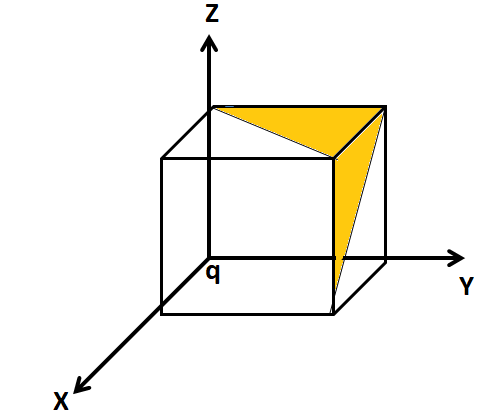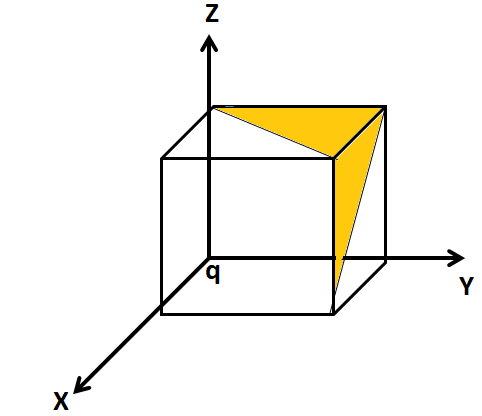
A charge ‘\[q\]’ is placed at one corner of a cube as shown in the figure. The flux of electrostatic field \[\vec E\] through the shaded area is:

A. \[q/48{\varepsilon _0}\]
B. \[q/8{\varepsilon _0}\]
C. \[q/24{\varepsilon _0}\]
D. \[q/4{\varepsilon _0}\]
Answer
219k+ views
Hint: In this question, we need to find the flux of electrostatic field \[\vec E\] through the shaded area. For this, the total flux through the cube and the total flux through one outer face of the cube. With the help of this, we have to find the total flux through the shaded area.
Complete step by step solution:
Consider the following figure.

We know whenever a charge q is positioned at the cube-corner; it is distributed evenly by eight cubes.
The total flux through the cube is given by,
\[{T_C} = \left( {q/{\varepsilon _0}} \right) \times \dfrac{1}{8}\]
\[{T_C} = \dfrac{q}{{8{\varepsilon _0}}}\]
However, there is only flux across three faces.
Thus, the total flux through one external face of the cube \[ = \left( {\dfrac{q}{{8{\varepsilon _0}}}} \right) \times \dfrac{1}{3}\]
This gives the total flux through one external face of the cube \[ = \left( {\dfrac{q}{{24{\varepsilon _0}}}} \right)\]
So, the total flux through shaded region is given by,
\[{T_S} = \left( {\dfrac{q}{{24{\varepsilon _0}}} + \dfrac{q}{{24{\varepsilon _0}}}} \right) \times \dfrac{1}{2}\]
By simplifying, we get
\[{T_S} = \dfrac{q}{{24{\varepsilon _0}}}\]
Here, half of every face is shaded by a cube.
Therefore, the correct option is (C).
Additional Information: We can say that the electric flux is described as the tally of the amount of electric field lines that penetrate a region. Here, the electric field lines are thought to start with positive charges and end with negative charges. We can denote it mathematically as \[\phi = E \times A\] where, \[\phi ,E\] and \[A\] are the electric flux, magnitude of electric field and area of the surface through which the electric flux is to be determined respectively.
Note: Many students make mistakes in finding the total flux through the shaded region. Also, we may get false results due to wrong calculations. This is the only way through which we can solve this example in a simplified way.
Complete step by step solution:
Consider the following figure.

We know whenever a charge q is positioned at the cube-corner; it is distributed evenly by eight cubes.
The total flux through the cube is given by,
\[{T_C} = \left( {q/{\varepsilon _0}} \right) \times \dfrac{1}{8}\]
\[{T_C} = \dfrac{q}{{8{\varepsilon _0}}}\]
However, there is only flux across three faces.
Thus, the total flux through one external face of the cube \[ = \left( {\dfrac{q}{{8{\varepsilon _0}}}} \right) \times \dfrac{1}{3}\]
This gives the total flux through one external face of the cube \[ = \left( {\dfrac{q}{{24{\varepsilon _0}}}} \right)\]
So, the total flux through shaded region is given by,
\[{T_S} = \left( {\dfrac{q}{{24{\varepsilon _0}}} + \dfrac{q}{{24{\varepsilon _0}}}} \right) \times \dfrac{1}{2}\]
By simplifying, we get
\[{T_S} = \dfrac{q}{{24{\varepsilon _0}}}\]
Here, half of every face is shaded by a cube.
Therefore, the correct option is (C).
Additional Information: We can say that the electric flux is described as the tally of the amount of electric field lines that penetrate a region. Here, the electric field lines are thought to start with positive charges and end with negative charges. We can denote it mathematically as \[\phi = E \times A\] where, \[\phi ,E\] and \[A\] are the electric flux, magnitude of electric field and area of the surface through which the electric flux is to be determined respectively.
Note: Many students make mistakes in finding the total flux through the shaded region. Also, we may get false results due to wrong calculations. This is the only way through which we can solve this example in a simplified way.
Recently Updated Pages
A square frame of side 10 cm and a long straight wire class 12 physics JEE_Main

The work done in slowly moving an electron of charge class 12 physics JEE_Main

Two identical charged spheres suspended from a common class 12 physics JEE_Main

According to Bohrs theory the timeaveraged magnetic class 12 physics JEE_Main

ill in the blanks Pure tungsten has A Low resistivity class 12 physics JEE_Main

The value of the resistor RS needed in the DC voltage class 12 physics JEE_Main

Trending doubts
JEE Main 2026: Application Form Open, Exam Dates, Syllabus, Eligibility & Question Papers

Understanding Uniform Acceleration in Physics

Derivation of Equation of Trajectory Explained for Students

Hybridisation in Chemistry – Concept, Types & Applications

Understanding the Angle of Deviation in a Prism

Understanding Collisions: Types and Examples for Students

Other Pages
JEE Advanced Marks vs Ranks 2025: Understanding Category-wise Qualifying Marks and Previous Year Cut-offs

Understanding Atomic Structure for Beginners

How to Convert a Galvanometer into an Ammeter or Voltmeter

Understanding Centrifugal Force in Physics

JEE Main Marking Scheme 2026- Paper-Wise Marks Distribution and Negative Marking Details

Degree of Dissociation: Meaning, Formula, Calculation & Uses




